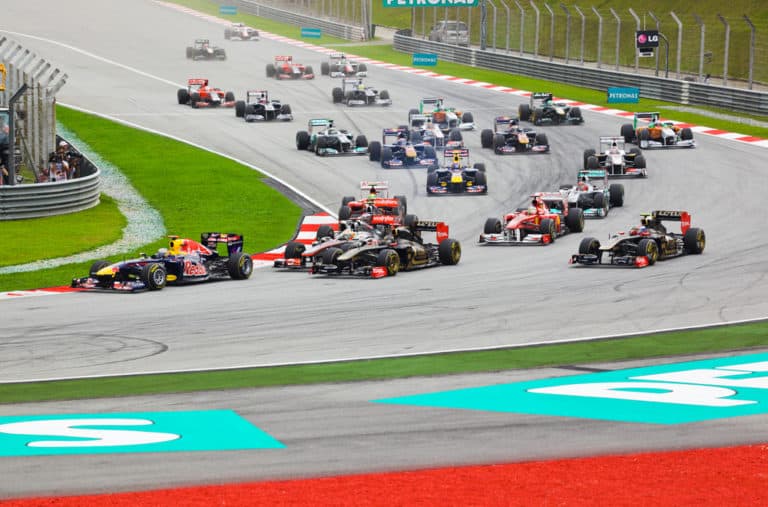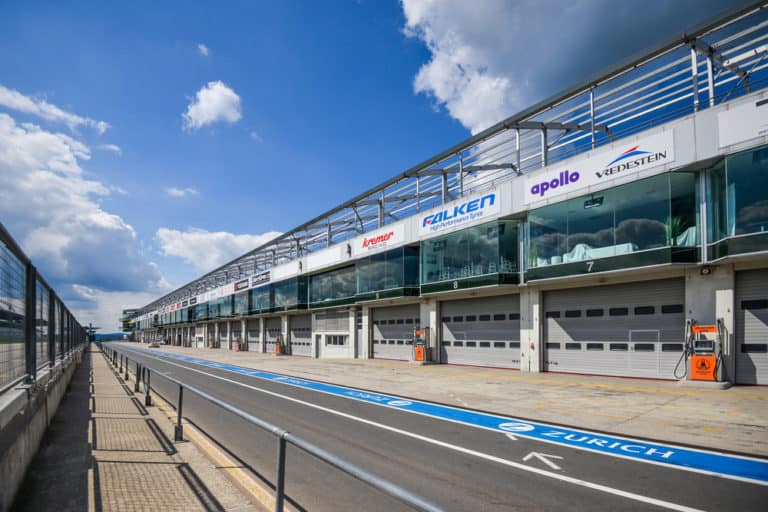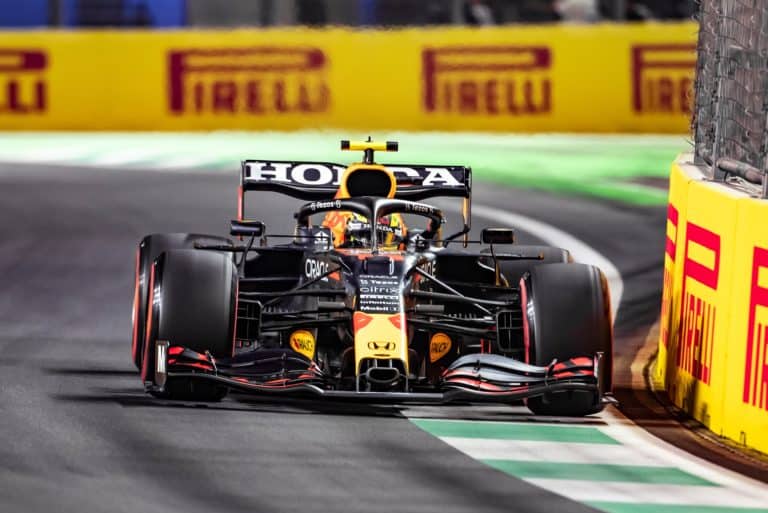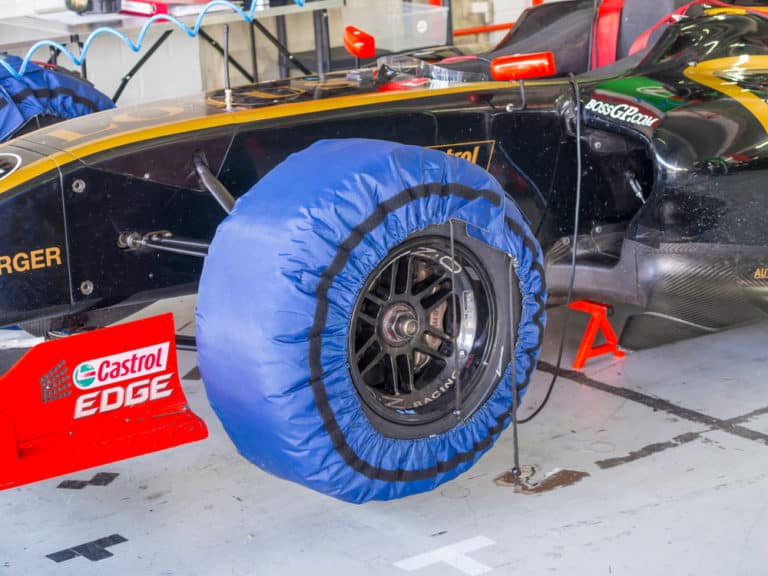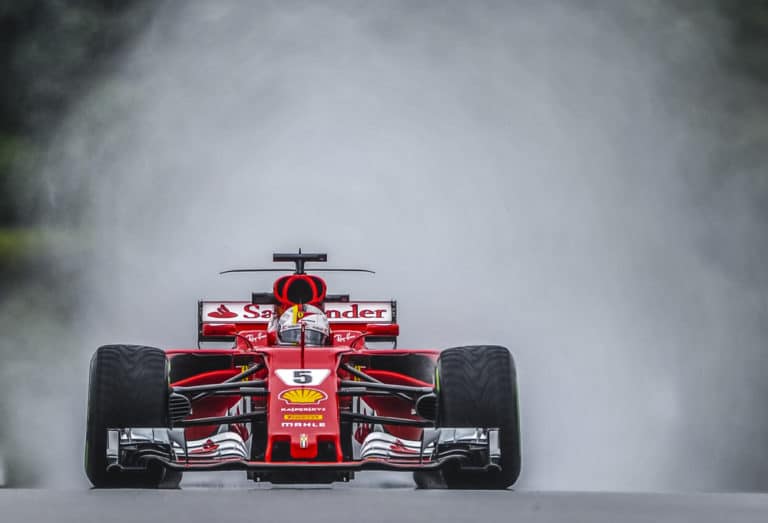The popularity of Formula 1 is growing quickly. This means that there are new Formula 1 fans made every day, and many new fans find themselves asking important questions. One such question asked by many F1 fans is how do F1 teammates work?
Formula 1 teammates drive for the same F1 team. The points scored by each driver accumulate to form the overall points scored by the F1 team. Teammates support one another on the track and offer points security and increase the possibility of good race results for the team.
Every Formula 1 team has two drivers competing in every race. This team setup comes with some distinct advantages and increases the success of the racing team. Let’s take a deeper dive into how F1 teammates work, why this system works well, why teams have two drivers and some of the drawbacks of having two drivers per team.
If you’re looking for some F1 merchandise, check out the awesome stuff at the official F1 store here.
How Do Formula 1 Teammates Work?
F1 is among the most popular motorsports and is quickly growing in popularity. The growing popularity of the sport internationally gives rise to the need to answer some questions that many F1 fans have. One such question is, how do F1 teammates work?
Every Formula 1 team on the grid has a team of two racing drivers. Broadly speaking, the reason for having a team of two drivers on the grid is to maximize the possibility of success on the track for the racing team as a whole.
Every driver on the Formula 1 track is competing on their own but having two drivers per team offers each team some distinct advantages.
Having two drivers maximizes the number of points that can be earned for the F1 team in every race. If both drivers finish in the top ten drivers, the team will collectively score points based on the finishing position of both drivers.
Having two teams also increases the chances of winning points overall; if one driver does not finish a race due to an accident or another unfortunate event, there is another driver that can score points for the team.
These reasons are very broad, but they are generally the main reasons for having a team of two drivers on every F1 team. We will dive deeper into these reasons later on, but there is more to discuss in this section before we get into the why of F1 teammates.
Formula 1 teammates work simply in this way: each Formula 1 team has two drivers that compete simultaneously. The finishing points of both drivers are allocated to the overall points score of the team for the season.
Drivers who race for the same team are teammates, and they should drive with each other’s best interests in mind, but they are still racing against one another and will compete fiercely for podiums and wins.
While teammates are meant to work as a team, the F1 team will often direct one driver to make way for another or to change places to place one driver in a better track position.
This is usually to ensure that one driver finishes with more points, to help ensure that the driver makes as big an impression as possible and enables them to get closer to winning the World Championship.
The drivers in an F1 team will race against each other, but the general idea is to try and score as many points for the team as possible while finishing as high up in the race order as possible, giving both driver and team a better position in the World Championship season.
How Does Scoring Work For F1 Teammates?
Having two divers per team in Formula 1 can lead to some confusion. There is much confusion among some fans regarding scoring for Formula 1 teammates. How does scoring work for F1 teammates?
Scoring for Formula 1 teammates works the same way as it does for every driver on the grid. The finishing position of each driver determines the points that the driver scores. The better position the driver finishes in, the more points the driver wins for the race.
To score points in a race, the driver must finish in the tenth position or higher. The first-place driver wins the highest number of points, and the points diminish down the grid until the tenth driver only scores one point.
Any driver finishing below the tenth position at the end of the race does not score any points.
The points that the drivers win in races accumulate to form the overall World Championship standings. The driver who accumulates the most race points at the end of the racing season wins the World Championship.
The points that the drivers earn are accumulated to form the overall team score for the racing season. The team with the most points at the end of the season wins the Constructors Championship.
The points scoring for two drivers in the same team work in the exact same way. However, with that being said, the team may favor one driver over the other if one driver has more points than the other.
It is better for the team to win the Constructors Championship and the Drivers’ Championship simultaneously, so the teams tend to favor the driver who scores more points as this driver is more likely to win the championship overall.
Teams will favor one driver by instructing the second driver to fall in behind the first, allowing the first driver to score more points.
Why Do Formula 1 Teams Have Two Drivers?
Every Formula 1 racing team on the grid has two drivers. This means that ten racing teams send 20 drivers onto the track every year. The two drivers in each team are teammates, and they are meant to be of benefit to one another and to the team overall, but what are the reasons for sending out two drivers per team in every race?
WE have already discussed some of the reasons why Formula 1 teams have two teams in every race, but let’s take a deeper look into why this is the standard in Formula 1.
The main two advantages of having two drivers per team in Formula 1 are maximum point scoring capabilities and increasing the likelihood of finishing the race in the points, rather than losing out on points altogether.
The points scoring system in Formula 1 is accumulative. This means that every point scored by each driver accumulates to form the drivers’ overall score for the season. The overall points scored by each driver are also added to the overall points of their F1 team. This means that the scores from both drivers go towards the overall score of the team.
Logically, this means that having two drivers earns more points for the team. If both drivers from the same team do very well in a race, for example finishing the race in the first and second positions, and if one of the drivers completes the fastest lap of the race, the team overall will win a score total of 44 points in one race.
This is a large number of points, considering that if both drivers from the same team placed ninth and tenth, the overall team score would amount to a total of just 3 points.
At the same time, having more than one driver in a race offers more security for the team. For example, if one driver has engine failure during a race and is unable to continue racing, that driver will not score any points. In this circumstance, the other driver is still able to score points for the team and keep the overall team in the running for the World Championship.
If the team has only one driver, the inability to finish a race will result in the team scoring no points at all.
Another reason why Formula 1 teams have two drivers are for better strategy development and deployment, which can include using the strengths of each driver to the advantage of the team and allowing the drivers to support one another on the track.
Having two drivers is integral for winning Championships, as the drivers support one another, score points together, and form the spearhead of the team that drives the team forward in to racing success.

Do F1 Drivers Help Each Other?
Having two drivers in one team has some distinct advantages, but how do these advantages actually translate to a race in the real world?
It stands to reason that two drivers on the track will be able to support one another, block other drivers, and offer aerodynamic advantages if possible, but this is rarely seen in the sport.
The truth is, most of the time, the two drivers of the same team are very separated on the track. Some of the bigger teams with the best racers and the best cars can be seen racing in tandem, for example, the Mercedes race cars of Lewis Hamilton and Valtteri Bottas can often be seen crossing the line one after the other, but for most teams, both drivers are fairly decently separated from one another.
However, if given the opportunity, the teams do encourage the drivers to support one another. Two drivers from the same racing team are often encouraged to block for one another, and the team is allowed to request that the cars trade places on the track to increase the standings and points scoring possibilities of one driver over another.
Teammate rivers do support one another when they can, but at the end of it, they are competitors and will race to win regardless of who is ear them on the track.
Do Formula 1 Teammates Get Along?
We have established that every F1 racing team employs two drivers and that these drivers are teammates and should like as such. The drivers are often required to support one another on the track, but do Formula 1 teammates get along?
Generally speaking, most Formula 1 driving teammates have a somewhat amicable relationship. Most drivers get along with their teammates to some extent, and there is not often in-fighting between drivers of the same team.
However, if one driver is often favored over another in order to win more points or to increase the standings of a team in a racing season, the less-favored driver is likely to carry some animosity toward the other driver and even the team.
There have been some instances of drivers coming to blows with one another, and there have been some occurrences of fights between teammates, but these occurrences are few and far between and generally unlikely.
Some teammates in Formula 1 become very good friends. There are drivers who work together well, driver together well, and become friends outside of Formula 1.
Every driver has respect for their peers, and this is true for the drivers within a team as well. Most drivers in Formula 1 are respectful of one another and prefer to let their driving do the talking.
What Happens If F1 Teammates Crash?
In the heat of a Formula 1 race, both drivers from the same team are required to support one another, but at the end of it, they are still racing drivers competing at their utmost to win the race. In these circumstances, accidents happen, and there have been instances of teammates crashing into one another.
If both teammates crash into one another, there are a few consequences that are likely to occur. If the accident is bad enough, the drivers may be unable to continue racing, resulting in zero points scored for either driver and the team overall, setting the team and the drivers at a disadvantage going forward in the racing season.
This occurrence may also result in an investigation by the FIA and the racing stewards, which may even result in penalties inflicted on the drivers and the racing team. This is likely to occur because the drivers are likely to have crashed due to unsafe racing practices while trying to best one another for a better racing position.
If this occurs, the penalties for the team and the drivers may be detrimental for the season, which means that teammates should avoid crashing into one another at all costs during a race.
Conclusion
Having two drivers per team in Formula 1 means that the team is more likely to score a higher number of points overall, which increases the standing of the team in the World Championship.
Using two drivers also ensures the team that if one driver is unable to finish, there is still a chance to score points for the team if the other driver does well.
In the end of it, using drivers is better for the team overall and makes the racing more exciting for the fans! How the teammates work is the same as all other drivers on the grid, and they do race each other, but they are also a support to one another, making a good driving team a force to be reckoned with!

